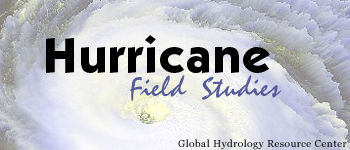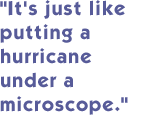

 |
by Annette Varani October 23, 2001 |
||
|
As hurricane-forecasting techniques have improved, the loss of life due to severe storms has steadily declined. Nevertheless, researchers at the National Hurricane Center estimate that over the past five centuries, Atlantic hurricane fatalities have ranged from one-third to one-half million people, with a conservative 160,000 fatalities along coastal North and Central America due to storms this century. Beyond the cost in lives, the damage storms inflict has risen to billions of dollars. As a case in point, Hurricane Andrew made landfall in 1992 to the tune of $26.5 billion. |

For more information, visit the Global Hydrology Resource Center at the Marshall Space Flight Center. (A new browser window will open.) |
||
|
"Forecasters are getting better every single year at predicting a hurricane's track. But knowing what the actual intensity is going to be when it makes landfall and gauging how much rainfall it's going to dump are areas that still need a lot of work," said Robbie Hood, of the Marshall Space Flight Center, Global Hydrology and Climate Center (GHCC) in Huntsville, Alabama. Hood was NASA's lead mission scientist on the Third Convection and Moisture Experiment (CAMEX-3) which included participants from six NASA field centers and seven universities.
"For instance, the Hurricane Center's statistics indicate that more people are killed from inland flooding and heavy rainfall in hurricane situations, than people who are actually killed along the coastline due to storm surges," Hood said. "That's because the message has gotten out. People know they need to evacuate and they know the tides are going to be high and storm surges are going to be significant, so officials are doing their jobs as far as evacuating folks, but inland flooding is still a tremendous problem," she said. Aiming to push the envelope on hurricane forecasting, atmospheric researchers and crews flew instrumented aircraft directly into hurricanes. Depending on that day's mission, CAMEX-3 participants flew bow tie patterns over the eye of the storm, studied activities within the hurricane, or circled the storm, measuring its outside water vapor environment and other atmospheric conditions, up to eight hours at a stretch. "We were trying to get a better three-dimensional picture of what a hurricane looks like in high detail," Hood said. CAMEX-3 followed two earlier CAMEX experiments completed in 1993 and 1995 that focused on detailed aspects of the hydrologic cycle. Each of the earlier CAMEX studies used prototype satellite instruments or instruments that mimicked existing satellite sensors. "Satellites monitor hurricanes too," Hood pointed out. "The differences are that most of the satellites only pass over once or twice a day, and the imagery that they collect is much coarser resolution because they're at higher altitude than our aircraft. We can fly lower and closer and see things in more detail. "Aircraft instruments use the same remote sensing techniques, but provide more details of conditions," she said. "It's just like putting the hurricane under a microscope. You can look at something with your eye, but when you put it under a microscope you can see specifics." In addition to the immediate value of studies underway, collecting data by under-flying satellites with the same or comparable instruments allows scientists to calibrate and validate data taken from space. Such exercises in "ground truth" provide facts that, when compared to space imagery, allow scientists to better understand satellite signatures, and how comparable space sensors portray climate and surface features.
Like earlier CAMEX field studies, CAMEX-3 again used the NASA ER-2 aircraft, but this time combined forces with research flights planned by the Air Force Reserve Hurricane Hunters and the National Oceanic and Atmospheric Administration. "We also brought in a NASA DC-8," Hood said. "The advantage of that aircraft is that we could fly at higher altitudes than is normally done. NOAA's hurricane research division flies two P-3s at 20,000 feet and below, so they're in the more intense precipitation and wind field closer to the surface. The DC-8 flies through hurricanes at 35,000 feet, and the ER-2 was above that at 65,000 feet. Working in parallel, the multi-agency teams collected an unprecedented set of hurricane data. "We tried to coordinate as best we could. Each agency has its own mission and its own priorities as to how it defines a mission, so there were dates when we just couldn't fly together, or some of the researchers had to sample different parts of the storm," Hood said, "but when we could, we aligned our flight tracks. "Sometimes that meant flying directly above each other in a stack format and sometimes that meant that we just tried to sample the same area of the storm at the same time." In only two months' field work in August and September of 1998, the researchers flew multiple missions each through four hurricanes--Bonnie, Danielle, Earl and Georges. They gathered measurements from three types of instruments, including passive microwave instruments designed to measure storm-emitted energy, ice and precipitation; active sensors such as radar and lasers, designed to gauge velocities and storm eye-wall structures; and in-situ instruments that collected air temperature, pressure and wind speeds. Of particular scientific interest, three of the storms studied made landfall. "We felt very fortunate that we were in the right position to sample those," Hood said, "because we wanted to study how the interaction with land actually changes a hurricane. A key question for hurricane forecasting is how much rain a hurricane's going to drop." The intensity of a particular hurricane at landfall is not a precise indicator of rain expected, Hood said. For instance, in September 1999, Hurricane Floyd was an intense storm nearly twice the size in diameter of typical Atlantic hurricanes. Shortly after it made landfall, Floyd quickly weakened to a tropical storm, but as it carried so much moisture and moved so slowly up the coast, it caused widespread flooding. "The way precipitation behaves from one day to the next may actually affect the intensity of a storm," Hood said. "But knowing whether a storm's structure changes once it interacts with land is an area still to be studied. I think to do that properly we're going to need to combine data from our experiment with global satellite rainfall data," Hood said. Now, with CAMEX and subsequent field work behind her, the atmospheric scientist is looking forward to digging into the data and examining precipitation structures. "We learned early in the experiment that hurricanes are much more complicated in the upper altitudes than we had expected. The traditional theory of a hurricane is that air flows in at the bottom and spirals up around the eye and then outflows at the top. At the altitudes we were flying, we noticed that there were inflows and outflows all over the place. There wasn't as steady a pattern as we had anticipated." CAMEX-3 data sets are still a work in progress, Hood said. "But now, researchers have a better three-dimensional picture because we have data from multiple hurricane levels." |
|||